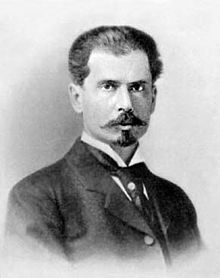
The Winogradsky column is a simple device for culturing a large diversity of microorganisms. Invented in the 1880s by Sergei Winogradsky, the device is a column of pond mud and water mixed with a carbon source such as newspaper (containing cellulose), blackened marshmallows or egg-shells (containing calcium carbonate), and a sulfur source such as gypsum (calcium sulfate) or egg yolk.
Incubating the column in sunlight for months results in an aerobic/anaerobic gradient as well as a sulfide gradient. These two gradients promote the growth of different microorganisms such as Clostridium, Desulfovibrio, Chlorobium, Chromatium, Rhodomicrobium, and Beggiato, as well as many other species of bacteria, cyanobacteria, and algae.
The column provides numerous gradients, depending on additive nutrients, from which the variety of aforementioned organisms can grow. The aerobic water phase and anaerobic mud or soil phase are one such distinction.
- Because of oxygen’s low solubility in water, the water quickly becomes anoxic (a total depletion in the level of oxygen) towards the mud and water interface.
- Anaerobic phototrophs are still present to a large extent in the mud phase, and there is still capacity for biofilm creation and colony expansion.
- Algae and other aerobic phototrophs are present along the upper half of the columns’ surface and water. Green growth is often attributed to these organisms.
How to make a Winogradsky column?
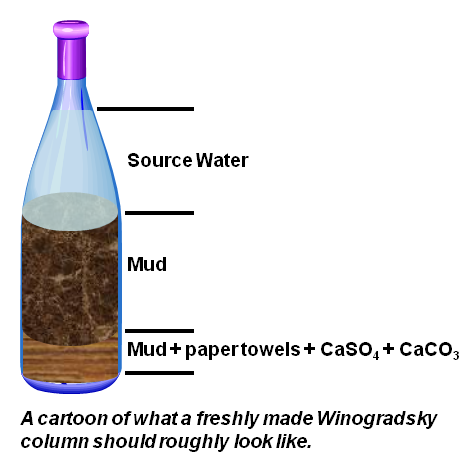
The column is a rough mixture of ingredients – exact measurements are not critical.
- A tall glass or plastic tube (30 cm long, >5 cm wide) is filled one-third full of pond mud, omitting any sticks, debris, and air bubbles.
- Supplementation of -0.25% w/w calcium carbonate and -0.50% w/w calcium sulfate or sodium sulfate is required (ground eggshell and egg yolk respectively are rich in these minerals), mixed in with some shredded newspaper or hay (for cellulose).
- An additional anaerobic layer, this time of unsupplemented mud, brings the container to two-thirds full.
- This is followed by water from the pond to saturate the mud and occupy half the remaining volume.
- The column is sealed tightly to prevent evaporation of water and incubated for several months in strong natural light.
Colonies saw in Winogradsky column
After the column is sealed tightly,
- The anaerobic bacteria will develop first, including Clostridium spp. These anaerobic bacteria will consume cellulose as an energy source. Once this commences they create CO2 that is used by other bacteria and thus the cycle begins.
- Eventually, color layers of different bacteria will appear in the column.
- At the bottom of the column will be green sulfur photosynthetic anaerobic bacteria.
- The layer above will be purple which is sulfur anaerobic bacteria.
- Followed by another column of purple anaerobic non-sulfur bacteria.
- And at the top will be a layer of Cyanobacteria which is sulfur-oxidizing bacteria. This top layer of aerobic bacteria produces CO2, which feeds back into the column creating a further reaction.

Limitations of Winogradsky column
While the Winogradsky column is an excellent tool to see whole communities of bacteria, it does not allow one to see the densities or individual bacterial colonies. It also takes a long time to complete its cycle. However, its importance in environmental microbiology should not be overlooked and it is still an excellent tool to determine the major bacterial communities in a sample.
What biomolecule do the newspaper, eggshells and gypsum contribute to the Winogradsky column?
- News papers: Source of carbon (Cellulose).
- Egg shell: Source of Calcium carbonate
- Gypsum: Source of Sulfur (Calcium sulfate)
Importance of Winogradsky column
One can discover several interesting things in the columns.
- Winogradsky columns are model microbial ecosystems.
- The microbes create two gradients, one of oxygen, the second of hydrogen sulfide. The oxygen is highest at the top and lowest at the bottom, the hydrogen sulfide gas is highest at the bottom and lowest at the top.
- When grown in the light, different bacteria have different pigments growing in many different layers, giving the different layers different colors.
(i) Green photosynthetic bacteria and algae are on top,
(ii) Upper decomposers (using aerobic respiration) follow,
(iii) There is usually both a red and a rust-colored layer of mud including photosynthetic bacteria that do not produce oxygen. (Except at the top, the photosynthetic bacteria are only under the glass or plastic, not deep inside the mud).
(iv) Lower decomposers (using anaerobic respiration) and chemosynthetic bacteria using sulfur are in the lowest layers.
- When grown in the dark, the column is much more uniform, having only about 2 layers.
(i) The number of bacteria species in the ecosystem is also reduced, there are mainly upper decomposers using aerobic respiration and lower decomposers using anaerobic respiration, and lower chemosynthetic organisms using sulfur.
- Winogradsky columns are important because they show us a microbial ecosystem and how they can change under different conditions, such as the presence of light. Microbial ecosystems are important because we are a walking microbial ecosystem.
Revised by
- Md. Siddiq Hasan on 01 April 2021
 Plantlet The Blogging Platform of Department of Botany, University of Dhaka
Plantlet The Blogging Platform of Department of Botany, University of Dhaka
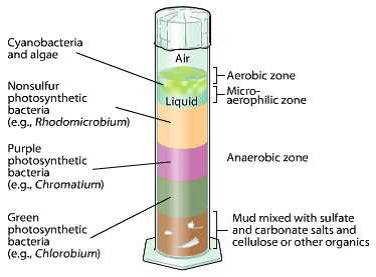



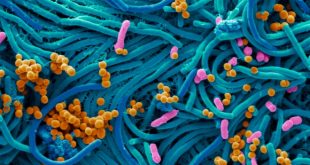
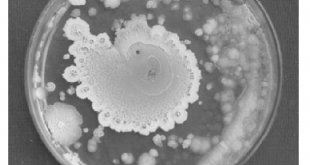
I have a question here. Suppose you design an experiment for measuring the activity of sulfur oxidising bacteria in soil. How would you prove that your activity measurement was due to biological activity
what are the purposes of using of sulfate, calcium carbonate, and cellulose in the soil for creating typical winogradsky columns.
I am currently writing a paper and a bug appeared in the paper. I found what I wanted from your article. Thank you very much. Your article gave me a lot of inspiration. But hope you can explain your point in more detail because I have some questions, thank you.